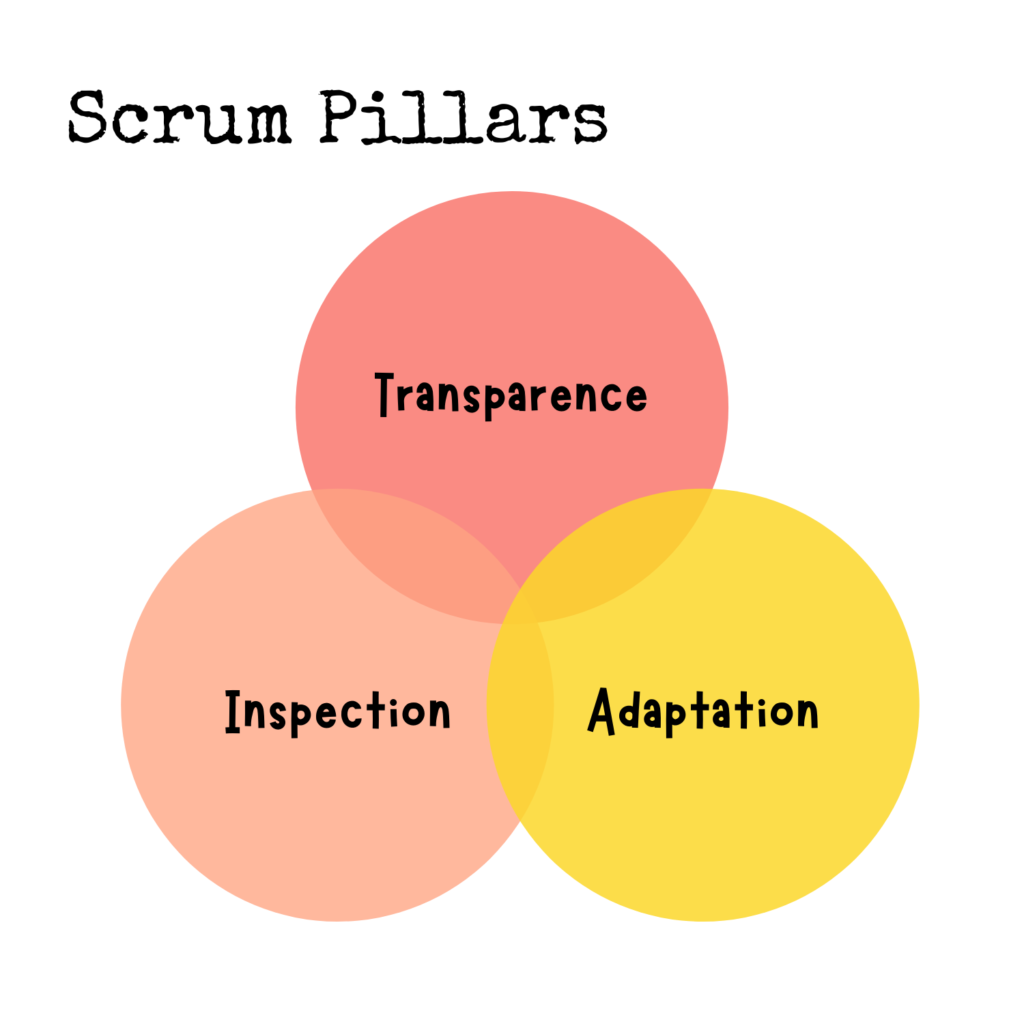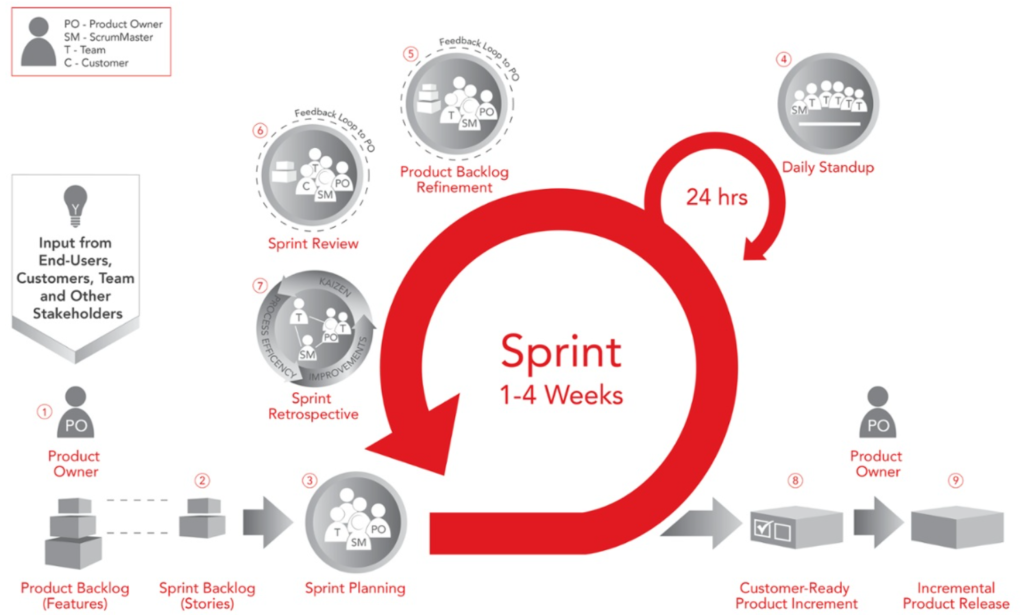As an agile framework, Scrum addresses traditional project management challenges such as the fluctuating needs of customers, thanks to its iterative and incremental work organization. Scrum’s capability to adapt to the customer’s needs can be considered its main advantage. The Scrum method operates in an incremental mode to offer pieces of the main product at each stage.
The History of Scrum
The term Scrum is derived from rugby, occurring when both teams interlock, a ball is fed into the Scrum, and it has to be kicked back while both teams drive against each other. The metaphor was first used in 1986 in a publication by Hirotaka Takeuchi and Ikujiro Nonaka entitled “The New Product Development Game”, which was applied to the industrial sector at the time. They introduced a new holistic approach to product development that would enhance speed and flexibility.
In 1995, Ken Schwaber and Jeff Sutherland presented a brief paper at the OOPSLA (Object-Oriented Programming, Systems, Languages, and Applications) conference in Austin, detailing the basics of what would later become the Scrum method.
In 2001, Ken and Jeff contributed to the development of the Agile Manifesto, and in 2011, they formalized the Scrum framework for the development, delivery, and maintenance of complex products in the Scrum guide.
Scrum Pillars
Scrum is founded on the theory of empirical process control, which is supported by three fundamental pillars:
- Transparency: being honest and transparent by making key aspects of the process visible to all of those who are responsible for the results.
- Inspection: inspecting processes and progress toward a Sprint Objective in order to detect unwanted deviations.
- Adaptation: the ability to adapt to changes in general; product changes, work processes changes, requirements changes, etc.

Scrum Values
When the team embodies and practices Scrum’s 5 main values, the pillars emerge to build trust between everyone. Therefore, the right application of Scrum relies on people’s capability of adopting these values:
- Commitment: Scrum team members are personally committed to achieving goals and project success.
- Courage: Scrum team members need to have the courage to do the right thing, admit that some functionalities are unattainable, and work on difficult issues.
- Focus: Scrum team members should focus on the Sprint work and team goals.
- Openness: Scrum Team members and stakeholders should be willing to be open about the work and the challenges of getting it done.
- Respect: Members of the Scrum team should respect each other and be aware of their capacities and independence.
Scrum Structure
Scrum is made up of Scrum teams, events, artifacts, and rules. Each component of this framework serves a specific purpose and is essential to the success and use of this framework.

Scrum Roles
Scrum defines three roles:
- The Scrum Master: is responsible for enforcing the application of the Scrum framework
- The Product Owner: is responsible for the product (the what)
- The development team: is responsible for the production (the how)
Scrum teams are self-organized, cross-functional teams. They choose the best way to get work done, rather than being directed by people outside the team, which promotes flexibility, creativity, and productivity.
Scrum Events
Along with the 3 main roles defined by Scrum, the framework involves five events:
- Backlog Review: allows you to have a vision of your product
- Sprint planning: allows you to determine the sprint goal
- Daily standup: allows you to synchronize your development team
- Sprint review: helps you collect customer feedback
- Sprint retrospective: helps you improve your practices
These 5 events promote transparency and quality. They are used to promote consistency and minimize the need for other meetings that are not defined by Scrum. All events are time-limited or time-boxed so that each event has a framed duration.
Scrum Artifacts
In addition to roles and events, there are three Scrum artifacts:
- The product backlog: an organized and prioritized list of everything required for creating the product
- The Sprint backlog: an estimation of the features that will be included in the subsequent increment
- Visible increment: Product Backlog items completed during the sprint as well as the cumulative value of increments delivered in previous sprints.
The first steps of adopting Scrum
Often, it’s a delicate process to transition from one approach to another. Here are some steps that you can follow to ease your Scrum adoption:
- Talk about the Scrum framework with your colleagues
- Get your supervisor on board by getting them interested in the process
- Follow a Scrum training
- Generate interest and support for the framework implementation from your colleagues
- Select a future Product Owner and make generate their interest in the position by explaining the Scrum process
- Start small with a team of persuaded and even passionate members (early adopters)
- Set up basic Scrum practices
Scrum certifications
Scrum certifications are becoming more popular and widely valued across all industries. The most common Scrum certifications are:
- Certified Scrum Master (CSM) by Scrum Alliance
- Advanced Certified ScrumMaster (A-CSM) by Scrum Alliance
- Certified Scrum Professional ScrumMaster (CSP-SM) by Scrum Alliance
- SAFe 4 Scrum Master by Scaled Agile
- SAFe 4 Advanced Scrum Master by Scaled Agile
- Professional Scrum Master (PSM) I, II, and III by Scrum.org
- Agile Certified Professional (PMI-ACP) by Project Management Institute (PMI)
Besides the above-mentioned certifications, certain project management credentials address both Agile and Scrum such as PMP and Prince2.
PMP Questions about Scrum
Question 1
You are managing a project using the Scrum framework. During sprint planning, the Scrum team realized that they had selected more items than they could realistically complete during a sprint. What should they do?
A. Ask the scrum master to allocate more resources to the team
B. Discuss the issue in the next sprint retrospective
C. Make more effort and even consider working overtime to finish the selected tasks
D. Inform the product owner that some items should be removed from the sprint
The correct answer is D. Since the Sprint hasn’t yet started, your team can still make changes to the Sprint Backlog items. During sprint planning, if the team realizes that they might not be able to accomplish the selected items, they can decide to remove some of them in consensus with the Product Owner, who is the only one in charge of prioritizing the sprint backlog items.
Question 2
Match the following Scrum events with the corresponding activities in the table below:
Sprint planning – Sprint execution – Sprint retrospective – Sprint review
| Activities | Scrum Event |
| A. Inspects progress towards the sprint goal | ———————– |
| B. Presents the project’s performance to the stakeholders | ———————– |
| C. Discusses the improvements that can be applied in the upcoming sprints | ———————– |
| D. Provides estimates of the required effort to complete user stories | ———————– |
A. Sprint execution: Inspects progress towards the sprint goal
B. Sprint review: Presents the project’s performance to the stakeholders
C. Sprint retrospective: Discusses the improvements that can be applied in the upcoming sprints
D. Sprint planning: Provides estimates of the required effort to complete user stories
Question 3
What is the Scrum Master’s role during the daily stand-up?
A. Congratulate the team when they do a good job
B. Listen to the team for any faced impediments
C. Ask each team member what they accomplished since the last daily standup
D. This meeting is for team members only, the Scrum Master should not attend
The correct answer is B. During the daily standup, the scrum master listens to the team members for any faced impediments and provides support in case of need. It’s recommended that the standup meeting is facilitated by any team member rather than the project manager to ensure it does not turn into a status meeting. Ideally, it is a time for the team to self-organize and make commitments to each other (Agile Practice Guide, page 54).
Scrum structure image credit: How Scrum works (Source: Scrum Inc.)
